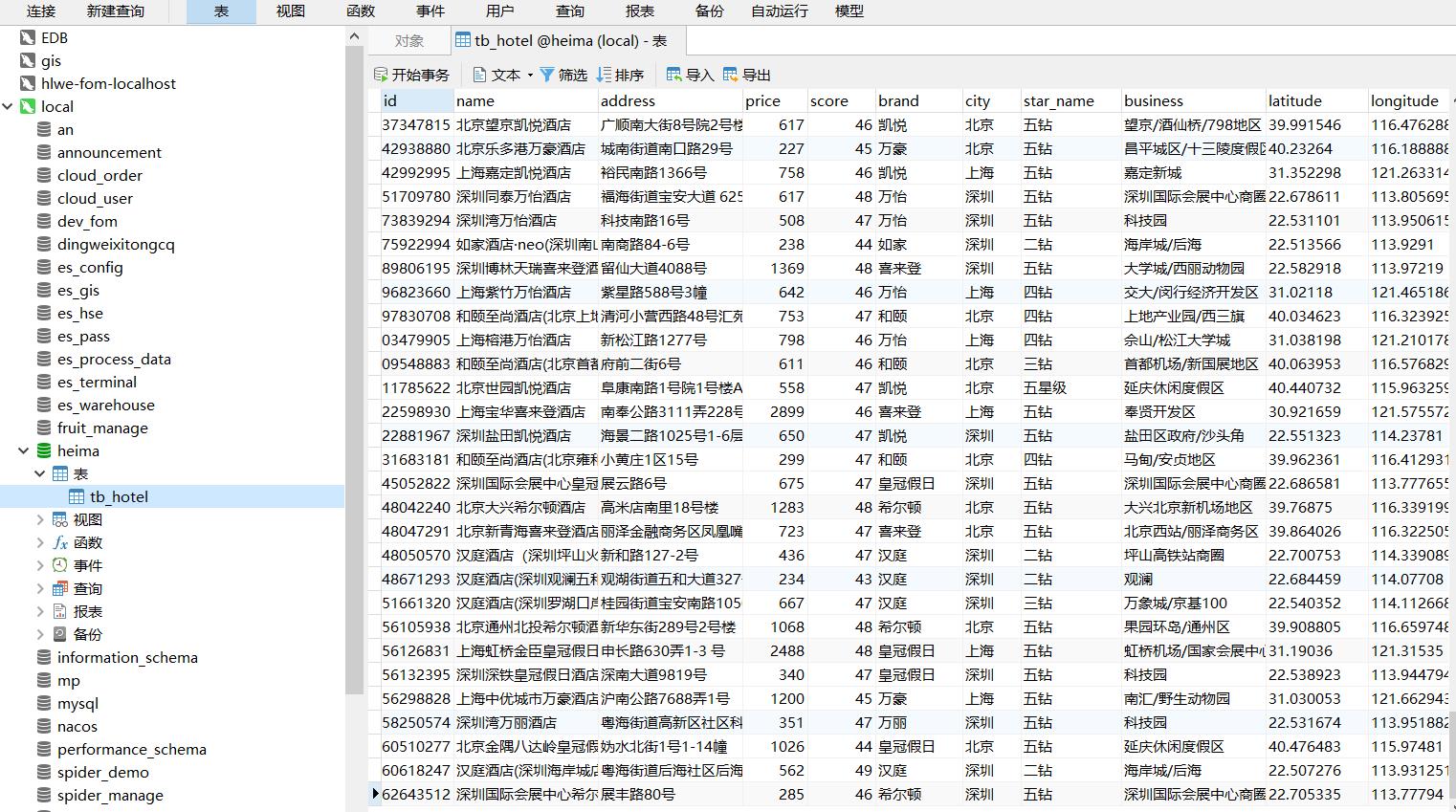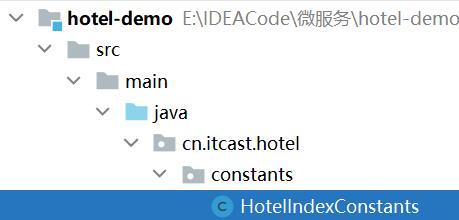Elasticsearch 分布式搜索引擎 -- RestClient操作索引库
Posted CodeJiao
tags:
篇首语:本文由小常识网(cha138.com)小编为大家整理,主要介绍了Elasticsearch 分布式搜索引擎 -- RestClient操作索引库相关的知识,希望对你有一定的参考价值。
文章目录
本节案例承接上节案例
课前资料:含代码和sql文件
链接:https://pan.baidu.com/s/1H9V7hZIC81XdPHqQN4ZCuA?pwd=3210
提取码:3210
1. RestClient
ES官方提供了各种不同语言的客户端,用来操作ES。这些客户端的本质就是组装DSL语句,通过http请求发送给ES。官方文档地址

其中的Java Rest Client又包括两种:
- Java Low Level Rest Client
- Java High Level Rest Client
我们学习的是Java HighLevel Rest Client客户端API
2. 案例:利用JavaRestClient实现创建、删除索引库,判断索引库是否存在
2.1 导入数据
首先导入课前资料提供的数据库数据:

数据结构如下:
CREATE TABLE `tb_hotel` (
`id` bigint(20) NOT NULL COMMENT '酒店id',
`name` varchar(255) NOT NULL COMMENT '酒店名称;例:7天酒店',
`address` varchar(255) NOT NULL COMMENT '酒店地址;例:航头路',
`price` int(10) NOT NULL COMMENT '酒店价格;例:329',
`score` int(2) NOT NULL COMMENT '酒店评分;例:45,就是4.5分',
`brand` varchar(32) NOT NULL COMMENT '酒店品牌;例:如家',
`city` varchar(32) NOT NULL COMMENT '所在城市;例:上海',
`star_name` varchar(16) DEFAULT NULL COMMENT '酒店星级,从低到高分别是:1星到5星,1钻到5钻',
`business` varchar(255) DEFAULT NULL COMMENT '商圈;例:虹桥',
`latitude` varchar(32) NOT NULL COMMENT '纬度;例:31.2497',
`longitude` varchar(32) NOT NULL COMMENT '经度;例:120.3925',
`pic` varchar(255) DEFAULT NULL COMMENT '酒店图片;例:/img/1.jpg',
PRIMARY KEY (`id`)
) ENGINE=InnoDB DEFAULT CHARSET=utf8mb4;
运行结果:

2.2 导入项目
然后导入课前资料提供的项目:

项目结构如图:

2.3 mapping映射分析
创建索引库,最关键的是mapping映射,而mapping映射要考虑的信息包括:
- 字段名
- 字段数据类型
- 是否参与搜索
- 是否需要分词
- 如果分词,分词器是什么?
其中:
- 字段名、字段数据类型,可以参考数据表结构的名称和类型
- 是否参与搜索要分析业务来判断,例如图片地址,就无需参与搜索
- 是否分词呢要看内容,内容如果是一个整体就无需分词,反之则要分词
- 分词器,我们可以统一使用ik_max_word
来看下酒店数据的索引库结构:
PUT /hotel
"mappings":
"properties":
"id":
# id统一使用keyword
"type": "keyword"
,
"name":
"type": "text",
"analyzer": "ik_max_word",
"copy_to": "all"
,
"address":
"type": "keyword",
"index": false
,
"price":
"type": "integer"
,
"score":
"type": "integer"
,
"brand":
"type": "keyword",
"copy_to": "all"
,
"city":
"type": "keyword",
"copy_to": "all"
,
"starName":
"type": "keyword"
,
"business":
"type": "keyword"
,
"location":
"type": "geo_point"
,
"pic":
"type": "keyword",
"index": false
,
"all":
"type": "text",
"analyzer": "ik_max_word"
执行结果:

几个特殊字段说明:
- location:地理坐标,里面包含精度、纬度
- all:一个组合字段,其目的是将多字段的值 利用copy_to合并,提供给用户搜索
地理坐标说明:

copy_to说明:(可以做到同时查询多个字段)

2.4 初始化RestClient
在elasticsearch提供的API中,与elasticsearch一切交互都封装在一个名为RestHighLevelClient的类中,必须先完成这个对象的初始化,建立与elasticsearch的连接。
分为三步:
1)引入es的RestHighLevelClient依赖:
<dependency>
<groupId>org.elasticsearch.client</groupId>
<artifactId>elasticsearch-rest-high-level-client</artifactId>
</dependency>
2)因为SpringBoot默认的ES版本是7.6.2,所以我们需要覆盖默认的ES版本:

我们自己去定义版本信息,强行覆盖默认的版本。

<properties>
<java.version>1.8</java.version>
<elasticsearch.version>7.12.1</elasticsearch.version>
</properties>
3)初始化RestHighLevelClient:
初始化的代码如下:

HotelIndexTest.java
package cn.itcast.hotel;
import org.apache.http.HttpHost;
import org.elasticsearch.client.RequestOptions;
import org.elasticsearch.client.RestClient;
import org.elasticsearch.client.RestHighLevelClient;
import org.elasticsearch.client.indices.CreateIndexRequest;
import org.elasticsearch.common.xcontent.XContentType;
import org.junit.jupiter.api.AfterEach;
import org.junit.jupiter.api.BeforeEach;
import org.junit.jupiter.api.Test;
import org.springframework.boot.test.context.SpringBootTest;
import java.io.IOException;
import static cn.itcast.hotel.constants.HotelIndexConstants.MAPPING_TEMPLATE;
@SpringBootTest
class HotelIndexTest
private RestHighLevelClient client;
@Test
public void testInit()
System.out.println(client);
@BeforeEach
void setUp()
client = new RestHighLevelClient(RestClient.builder(
HttpHost.create("http://192.168.135.130:9200")
));
@AfterEach
void tearDown() throws IOException
client.close();
运行结果:

2.5 创建索引库

代码分为三步:
- 1)创建Request对象。因为是创建索引库的操作,因此Request是CreateIndexRequest。
- 2)添加请求参数,其实就是DSL的JSON参数部分。因为json字符串很长,这里是定义了静态字符串常量MAPPING_TEMPLATE,让代码看起来更加优雅。
- 3)发送请求,client.indices()方法的返回值是IndicesClient类型,封装了所有与索引库操作有关的方法。


HotelIndexTest.java
package cn.itcast.hotel;
import org.apache.http.HttpHost;
import org.elasticsearch.client.RequestOptions;
import org.elasticsearch.client.RestClient;
import org.elasticsearch.client.RestHighLevelClient;
import org.elasticsearch.client.indices.CreateIndexRequest;
import org.elasticsearch.common.xcontent.XContentType;
import org.junit.jupiter.api.AfterEach;
import org.junit.jupiter.api.BeforeEach;
import org.junit.jupiter.api.Test;
import org.springframework.boot.test.context.SpringBootTest;
import java.io.IOException;
import static cn.itcast.hotel.constants.HotelIndexConstants.MAPPING_TEMPLATE;
@SpringBootTest
class HotelIndexTest
private RestHighLevelClient client;
@Test
public void testInit()
System.out.println(client);
@Test
void testCreateIndex() throws IOException
// 1.准备Request PUT /hotel
CreateIndexRequest request = new CreateIndexRequest("hotel");
// 2.准备请求参数
request.source(MAPPING_TEMPLATE, XContentType.JSON);
// 3.发送请求
client.indices().create(request, RequestOptions.DEFAULT);
@BeforeEach
void setUp()
client = new RestHighLevelClient(RestClient.builder(
HttpHost.create("http://192.168.135.130:9200")
));
@AfterEach
void tearDown() throws IOException
client.close();
我们去定义字符串常量:

package cn.itcast.hotel.constants;
public class HotelIndexConstants
public static final String MAPPING_TEMPLATE = "\\n" +
" \\"mappings\\": \\n" +
" \\"properties\\": \\n" +
" \\"id\\": \\n" +
" \\"type\\": \\"keyword\\"\\n" +
" ,\\n" +
" \\"name\\": \\n" +
" \\"type\\": \\"text\\",\\n" +
" \\"analyzer\\": \\"ik_max_word\\",\\n" +
" \\"copy_to\\": \\"all\\"\\n" +
" ,\\n" +
" \\"address\\": \\n" +
" \\"type\\": \\"keyword\\",\\n" +
" \\"index\\": false\\n" +
" ,\\n" +
" \\"price\\": \\n" +
" \\"type\\": \\"integer\\"\\n" +
" ,\\n" +
" \\"score\\": \\n" +
" \\"type\\": \\"integer\\"\\n" +
" ,\\n" +
" \\"brand\\": \\n" +
" \\"type\\": \\"keyword\\",\\n" +
" \\"copy_to\\": \\"all\\"\\n" +
" ,\\n" +
" \\"city\\": \\n" +
" \\"type\\": \\"keyword\\"\\n" +
" ,\\n" +
" \\"starName\\": \\n" +
" \\"type\\": \\"keyword\\"\\n" +
" ,\\n" +
" \\"business\\": \\n" +
" \\"type\\": \\"keyword\\",\\n" +
" \\"copy_to\\": \\"all\\"\\n" +
" ,\\n" +
" \\"pic\\": \\n" +
" \\"type\\": \\"keyword\\",\\n" +
" \\"index\\": false\\n" +
" ,\\n" +
" \\"location\\": \\n" +
" \\"type\\": \\"geo_point\\"\\n" +
" ,\\n" +
" \\"all\\": \\n" +
" \\"type\\": \\"text\\",\\n" +
" \\"analyzer\\": \\"ik_max_word\\"\\n" +
" \\n" +
" \\n" +
" \\n" +
"";
运行结果:


2.6 删除索引库、判断索引库是否存在


/**
* 判断索引库是否存在
*/
@Test
void testExistsIndex() throws IOException
// 1.准备Request
GetIndexRequest request = new GetIndexRequest("hotel");
// 3.发送请求
boolean isExists = client.indices().exists(request, RequestOptions.DEFAULT);
System.out.println(isExists ? "存在" : "不存在");
/**
* 删除索引库
*/
@Test
void testDeleteIndex() throws IOException
// 1.准备Request
DeleteIndexRequest request = new DeleteIndexRequest("hotel");
// 3.发送请求
client.indices().delete(request, RequestOptions.DEFAULT);
运行结果:



2.7 小结
JavaRestClient操作elasticsearch的流程基本类似。核心是client.indices()方法来获取索引库的操作对象。
索引库操作的基本步骤:
- 初始化RestHighLevelClient
- 创建XxxIndexRequest。XXX是Create、Get、Delete
- 准备DSL( Create时需要,其它是无参)
- 发送请求。调用RestHighLevelClient#indices().xxx()方法,xxx是create、exists、delete
以上是关于Elasticsearch 分布式搜索引擎 -- RestClient操作索引库的主要内容,如果未能解决你的问题,请参考以下文章